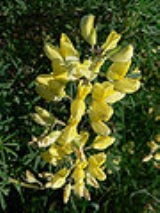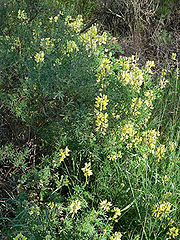
Lupinus arboreus
Encyclopedia
Lupinus arboreus is a species of lupin
e native to the western United States
in California
, where it is widely distributed among coastal scrub and sand dunes. Because it has been widely introduced, there is some uncertainty about its native range; it is thought to be native from Point Reyes National Seashore
south to San Luis Obispo County
.
 It is a perennial shrub
It is a perennial shrub
growing to 2 m tall (hence the alternative common name, tree lupine) in sheltered situations, but more typically 1-1.5 m tall. It has green to gray-green palmate leaves, with 5-12 leaflets per leaf. The leaflets are 2-6 cm long, often sparsely covered with fine silky hairs. Both yellow and lilac to purple flowering forms are known; however, the yellow form is more common, except in the north of the species' range. It is capable of tolerating temperatures down to -12°C and living for up to seven years.
for its attractive yellow flowers and also to bind drifting sand dunes. It has however escaped from cultivation to become an invasive species
in many areas. Outside of its native range in North America, it is somewhat invasive both in southern California, and further north to southwestern Canada
. It has also been introduced in western Europe
, Australia
(where it is considered a potential noxious weed), New Zealand
, Anatolia Aegean Region of Turkey and southern South America
, including the Falkland Islands
.
Like many members of the family Fabaceae
, it is an effective fixer of nitrogen
in the soil. Where it has been introduced, it changes the chemistry of the soil, and therefore allows other exotics to establish themselves, to the detriment of native vegetation adapted to low nitrogen levels. It also hybridizes with other lupine species such as Lupinus littoralis
(seashore lupin) and Lupinus rivularis
(riverbank lupin), further endangering the survival of those forms.
Lupin
Lupinus, commonly known as Lupins or lupines , is a genus in the legume family . The genus comprises about 280 species , with major centers of diversity in South and western North America , and the Andes and secondary centers in the Mediterranean region and Africa Lupinus, commonly known as Lupins...
e native to the western United States
United States
The United States of America is a federal constitutional republic comprising fifty states and a federal district...
in California
California
California is a state located on the West Coast of the United States. It is by far the most populous U.S. state, and the third-largest by land area...
, where it is widely distributed among coastal scrub and sand dunes. Because it has been widely introduced, there is some uncertainty about its native range; it is thought to be native from Point Reyes National Seashore
Point Reyes National Seashore
Point Reyes National Seashore is a park preserve located on the Point Reyes Peninsula in Marin County, California, USA. As a national seashore, it is maintained by the US National Park Service as a nationally important nature preserve within which existing agricultural uses are allowed to continue...
south to San Luis Obispo County
San Luis Obispo County, California
San Luis Obispo County is a county located along the Pacific Ocean in the Central Coast of the U.S. state of California, between Los Angeles and the San Francisco Bay Area. As of the 2010 census its population was 269,637, up from 246,681 at the 2000 census...
.

Shrub
A shrub or bush is distinguished from a tree by its multiple stems and shorter height, usually under 5–6 m tall. A large number of plants may become either shrubs or trees, depending on the growing conditions they experience...
growing to 2 m tall (hence the alternative common name, tree lupine) in sheltered situations, but more typically 1-1.5 m tall. It has green to gray-green palmate leaves, with 5-12 leaflets per leaf. The leaflets are 2-6 cm long, often sparsely covered with fine silky hairs. Both yellow and lilac to purple flowering forms are known; however, the yellow form is more common, except in the north of the species' range. It is capable of tolerating temperatures down to -12°C and living for up to seven years.
Cultivation
The yellow-flowering form is widely grown as an ornamental plantOrnamental plant
Ornamental plants are plants that are grown for decorative purposes in gardens and landscape design projects, as house plants, for cut flowers and specimen display...
for its attractive yellow flowers and also to bind drifting sand dunes. It has however escaped from cultivation to become an invasive species
Invasive species
"Invasive species", or invasive exotics, is a nomenclature term and categorization phrase used for flora and fauna, and for specific restoration-preservation processes in native habitats, with several definitions....
in many areas. Outside of its native range in North America, it is somewhat invasive both in southern California, and further north to southwestern Canada
Canada
Canada is a North American country consisting of ten provinces and three territories. Located in the northern part of the continent, it extends from the Atlantic Ocean in the east to the Pacific Ocean in the west, and northward into the Arctic Ocean...
. It has also been introduced in western Europe
Europe
Europe is, by convention, one of the world's seven continents. Comprising the westernmost peninsula of Eurasia, Europe is generally 'divided' from Asia to its east by the watershed divides of the Ural and Caucasus Mountains, the Ural River, the Caspian and Black Seas, and the waterways connecting...
, Australia
Australia
Australia , officially the Commonwealth of Australia, is a country in the Southern Hemisphere comprising the mainland of the Australian continent, the island of Tasmania, and numerous smaller islands in the Indian and Pacific Oceans. It is the world's sixth-largest country by total area...
(where it is considered a potential noxious weed), New Zealand
New Zealand
New Zealand is an island country in the south-western Pacific Ocean comprising two main landmasses and numerous smaller islands. The country is situated some east of Australia across the Tasman Sea, and roughly south of the Pacific island nations of New Caledonia, Fiji, and Tonga...
, Anatolia Aegean Region of Turkey and southern South America
South America
South America is a continent situated in the Western Hemisphere, mostly in the Southern Hemisphere, with a relatively small portion in the Northern Hemisphere. The continent is also considered a subcontinent of the Americas. It is bordered on the west by the Pacific Ocean and on the north and east...
, including the Falkland Islands
Falkland Islands
The Falkland Islands are an archipelago in the South Atlantic Ocean, located about from the coast of mainland South America. The archipelago consists of East Falkland, West Falkland and 776 lesser islands. The capital, Stanley, is on East Falkland...
.
Like many members of the family Fabaceae
Fabaceae
The Fabaceae or Leguminosae, commonly known as the legume, pea, or bean family, is a large and economically important family of flowering plants. The group is the third largest land plant family, behind only the Orchidaceae and Asteraceae, with 730 genera and over 19,400 species...
, it is an effective fixer of nitrogen
Nitrogen fixation
Nitrogen fixation is the natural process, either biological or abiotic, by which nitrogen in the atmosphere is converted into ammonia . This process is essential for life because fixed nitrogen is required to biosynthesize the basic building blocks of life, e.g., nucleotides for DNA and RNA and...
in the soil. Where it has been introduced, it changes the chemistry of the soil, and therefore allows other exotics to establish themselves, to the detriment of native vegetation adapted to low nitrogen levels. It also hybridizes with other lupine species such as Lupinus littoralis
Lupinus littoralis
Lupinus littoralis is a species of lupine known by the common name seashore lupine. It is native to the coastline of western North America from British Columbia to northern California, where it grows in sandy habitat. It is a low perennial herb or subshrub growing in a clump or mat no more than 30...
(seashore lupin) and Lupinus rivularis
Lupinus rivularis
Lupinus rivularis is a species of lupine known by the common name riverbank lupine. It is native to western North America from southern British Columbia to northern California, where it is known mainly from coastal habitat. This is a robust, erect perennial herb or subshrub growing up to about a...
(riverbank lupin), further endangering the survival of those forms.
Related species
A number of other related species of lupine also grow as bushes. They include:- Lupinus chamissonisLupinus chamissonisLupinus chamissonis is a species of lupine known by the common name Chamisso bush lupine. It is endemic to California, where it is known from most of the length of the coastline. It grows in sand dunes and other immediate coastal habitat....
Chamisso bush lupine, silver bush lupine - Lupinus albifronsLupinus albifronsLupinus albifrons, Silver lupine, white-leaf bush lupine, or evergreen lupine, is a species of lupine . It is native to California and Oregon, where it grows along the coast and in dry and open meadows, prairies and forest clearings...
Bush lupine - Lupinus excubitusLupinus excubitusLupinus excubitus is a species of lupine known as the grape soda lupine. Its common name refers to its sweet scent, which is said to be very reminiscent of grape soda. This species and its variants are found in the Southwestern United States, especially in California, and in far Northwestern...
Grape soda lupine - Lupinus longifoliusLupinus longifoliusLupinus longifolius is a species of lupine known by the common name longleaf bush lupine. It is native to the coastal mountain ranges and hillsides of southern California and Baja California, where it grows in local habitat in the canyons and slopes, such as scrub and chaparral.-Description:Lupinus...
Longleaf bush lupine

